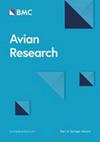Responses of steppe birds to habitat fragmentation: Insights from niche specialization and functional traits
IF 1.7
2区 生物学
Q1 ORNITHOLOGY
引用次数: 0
Abstract
Habitat fragmentation poses a significant threat to bird communities, especially those in open and semi-open ecosystems such as steppes. This study investigates how steppe birds adapt to and utilize fragmented habitats by combining niche modeling with ecological trait analysis. We conducted standardized point surveys to examine the habitat preferences of 32 bird species in Inner Mongolia, China, and quantified their habitat niche parameters using the Outlying Mean Index (OMI). Our results reveal distinct habitat preferences among species, with some thriving in intact environments while others are better adapted to fragmented areas. Grassland species showed high specialization along the fragmentation gradient, while others exhibited adaptability to varying levels of fragmentation. Using a Generalized Additive Model (GAM), we identified three key traits influencing habitat occupancy: hand-wing index, body mass, and range size. Specifically, species with medium hand-wing indices, moderate body mass, and larger range sizes were more likely to occupy heavily fragmented habitats. These findings provide empirical evidence on how habitat fragmentation affects bird species in steppe ecosystems. The study highlights the importance of functional traits in understanding avian responses to habitat fragmentation and offers a foundation for developing effective conservation strategies to preserve biodiversity in fragmented landscapes.
草原鸟类对栖息地破碎化的响应:来自生态位专业化和功能特征的见解
栖息地破碎化对鸟类群落构成了重大威胁,特别是在草原等开放和半开放生态系统中。本文采用生态位模型和生态性状分析相结合的方法,研究草原鸟类对破碎化生境的适应和利用。采用标准化的点调查方法,对内蒙古32种鸟类的生境偏好进行了研究,并采用离群平均指数(OMI)对其生境生态位参数进行了量化。我们的研究结果揭示了物种之间不同的栖息地偏好,一些物种在完整的环境中茁壮成长,而另一些物种则更适应破碎的环境。草地物种在破碎化梯度上表现出高度的专门化,而其他物种则表现出对不同破碎化程度的适应性。利用广义加性模型(GAM),我们确定了影响栖息地占用的三个关键特征:手翼指数、体重和范围大小。其中,手翅指数中等、体质量中等、范围较大的物种更有可能占据破碎化程度较重的栖息地。这些发现为草原生态系统中栖息地破碎化如何影响鸟类物种提供了经验证据。该研究强调了功能性状在理解鸟类对栖息地破碎化反应中的重要性,并为制定有效的保护策略以保护破碎化景观中的生物多样性提供了基础。
本文章由计算机程序翻译,如有差异,请以英文原文为准。
求助全文
约1分钟内获得全文
求助全文
来源期刊

Avian Research
ORNITHOLOGY-
CiteScore
2.90
自引率
16.70%
发文量
456
审稿时长
46 days
期刊介绍:
Avian Research is an open access, peer-reviewed journal publishing high quality research and review articles on all aspects of ornithology from all over the world. It aims to report the latest and most significant progress in ornithology and to encourage exchange of ideas among international ornithologists. As an open access journal, Avian Research provides a unique opportunity to publish high quality contents that will be internationally accessible to any reader at no cost.
 求助内容:
求助内容: 应助结果提醒方式:
应助结果提醒方式:


